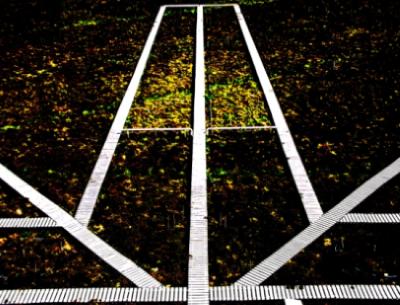The dry NH3 transect is 60 m long × 10 m wide. NH3 is released from a 10 m long pipe source down the transect; the NH3 system fumigates when the wind direction is in the right sector between 180° and 215°, and the wind speed is above 2.5 m s-1. The NH3 system uses the measured parameters of the previous minute and if they meet the above requirements it will then fumigate for 1 minute (Leith et al., 2004).


Figures: (1) Dry transect; (2) Contrast of dry transect showing areas of damage.
The NH3 concentration decrease down the transect, with average annual concentrations ranging from ambient (c. 0.5 µg NH3 m-3) to up to 100 µg NH3 m-3 near the point source. Peak concentrations at the source during fumigation events can reach 1600 µg NH3 m-3. Annual NH3-N deposition along the transect in 2003–2006 was calculated as 3.0 kg NH3-N ha-1 y-1 at the ambient position, and at the point source this has been calculated at 50–70 kg NH3-N ha-1 y-1 at annual average air concentrations of 70–90 mg NH3 m-3 (Cape et al., 2008).
After one year of fumigation, deleterious effects of high concentrations of dry-deposited NH3 could be measured on several key species. Over time, damage has been detected further down the transect at lower concentrations and with accumulated N dose, and is linked to secondary environmental stresses such as cold winters or dry summers. Calluna and species of Cladonia lichen and the bog moss Sphagnum have now disappeared from parts of the dry NH3 transect where inputs exceed 10 kg N ha-1 y-1.



 Figures: (1) Bleaching of Cladonia deom from NH3 fumigation; (2) Death of Cladonia from NH3 fumigiation; (3) Domination of Eriophorum and grasses; (4) Loss of Calluna vulgaris.
Figures: (1) Bleaching of Cladonia deom from NH3 fumigation; (2) Death of Cladonia from NH3 fumigiation; (3) Domination of Eriophorum and grasses; (4) Loss of Calluna vulgaris.

